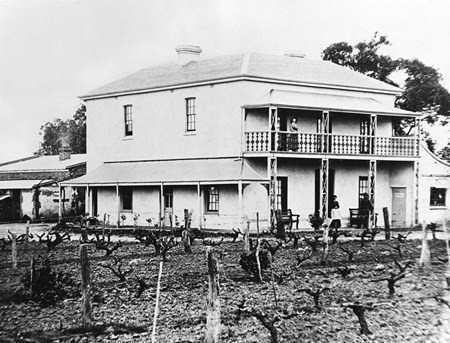The other day a friend told me that I don’t write enough about Australian wines, despite the fact that I wrote about them only some weeks ago. Honestly, some people are never satisfied. Anyway, ever eager to please, here’s some news about two more. But first, let me set the historical perspective. Now if the mention of such a thing causes your eyes to glaze over, you can skip all this and jump to the reviews. In fact, if you’re going to take that attitude, you can skip the whole column. It’s no skin off my nose. Just don’t be surprised if I ignore you in the street, that’s all.
In January 1830, the infant Thomas Hardy first saw the light of day in the west of England. Twenty years later, he travelled to South Australia but in those days of sail, the journey took a staggering twelve weeks. When he finally arrived there, he did various jobs mostly on farms, but along the way he picked up knowledge about wine-making. After a stint in the goldfields of Victoria and working as a butcher and cattle drover, he was finally able to start growing his own vines.
 Bankside homestead in 1874.
Bankside homestead in 1874.
In 1853 Thomas Hardy bought a property of about forty-six acres on the River Torrens which he called Bankside. The following year he planted a couple of acres of fruit trees and just under an acre of Shiraz vines. He made his first wine three years later and exported two hogsheads to England. From these modest beginnings, The Hardy Wine Company was established in Adelaide and it soon became South Australia’s largest winemaker. Hardys (without an apostrophe) has grown into a massive organisation. Today, the company produces a very wide range of wines including the Nottage Hill selection, which first appeared over forty years ago. This range includes a dozen varietals, crafted for consistency which means that each one will taste pretty much the same from year to year.
And just in case you’re wondering, Nottage Hill was named after Old Tom Nottage, who sounds like a character in a rustic folk-song. But he was once Young Tom Nottage and the nephew of Thomas Hardy. He worked for the company for sixty-six years and on his retirement, one of the prime vineyards was renamed Nottage Hill in his honour.
Hardys Nottage Hill Chardonnay 2012 (white), Australia (Bt. 699 @ Tesco-Lotus)
If you hold your glass against a plain white background, assuming that you have the necessary energy and inclination, you’ll see the attractive greenish-gold colour of this wine. Swirl it around and those long “legs” will appear. Without writing a paragraph on advanced physics, which would be a challenge for both of us, let me just say that they are caused by surface tension and known as The Marangoni Effect. If you feel compelled to pursue the matter further, a mathematical explanation together with thrilling thermodynamic equations can be found in Subrahmanyan Chandrasekhar’s text-book evocatively entitled Hydrodynamic and Hydromagnetic Stability. It probably doesn’t have very many jokes.
But back to the wine. There’s an almost creamy Chardonnay aroma. I know the expression “tropical fruits” is a bit of a cliché but that’s what springs to mind. If you want me to be more specific, then I will. (You’ll understand of course that there is a small charge for this additional service, for expertise doesn’t come cheap.) Well then, pineapple comes out first with white peaches and melon in the background. There’s just a hint of citrus and a suggestion of oak and honey. There’s also a vague hint of cucumber which I know is not a tropical fruit, but you did ask for more details. Right, that’s fifty baht please. Leave the money on the table when you leave.
This full-bodied wine has a lovely silky-soft mouth-feel with plenty of fruit up front. However, it’s pretty dry with a dash of acidity and there’s a rather elegant long finish with a faint mineral flavour in the background. At just over 13.5% alcohol, the wine is easy to drink and undemanding, so it would be very pleasing on its own. It would work well with seafood or chicken dishes and some milder Thai dishes too. Serve it quite cold but not freezing, otherwise the aromas won’t come through.
Hardys Nottage Hill Riesling 2012 (white), Australia (Bt. 699 @ Tesco-Lotus)
Riesling (REEZ-ling) has a long history. It can be traced back to 1435 when it was listed as growing in the vineyards of the splendidly-named Count John the Fourth of Katzenelnbogen. The spiritual home of Riesling is Germany’s Rhine and Mosel Valleys, but it makes fine wines in Alsace too. Rieslings usually have high acidity, delicate flavours, low alcohol and a characteristic mineral quality. The Rieslings from Alsace are aromatic, elegant wines quite different to their German cousins. Contrary to popular belief, German Rieslings, with a few notable exceptions are nearly always very dry. This Australian one is a lovely pale straw colour and has a delightful rich aroma of lemon and lime, pineapple and warm spices. When the wine has had enough contact with the air, you might also pick up the faint and strangely attractive smell of kerosene (better known to some people as paraffin). It might sound odd, but a delicate petrol-like aroma is typical of some good Rieslings.
It’s a fairly light-bodied wine but pretty dry too, with a soft and beguiling mouth-feel. There’s a good dash of lively mineral acidity, giving the wine a crisp flavour which continues through the lingering fruity finish. This is a lovely example of an Australian Riesling, pleasingly assertive and with quite a bit of character. At 12.5% alcohol, it would make a good partner for fish, pork or chicken dishes. Incidentally, Riesling is one of the few wines that can stand up to spicy Thai or Chinese food, but you’ll need to serve it cold to bring out the attractive freshness. Give it an hour in the fridge, I’d say. And don’t forget the fifty baht.




